
Gogebic County is a county in the Upper Peninsula of the U.S. state of Michigan. As of the 2020 census, the population was 14,380. The county seat is Bessemer. Gogebic County is the westernmost county in Michigan, and is one of four Michigan counties within the Central Time Zone. Gogebic County borders Wisconsin to the south, and has a shoreline on Lake Superior to the north.
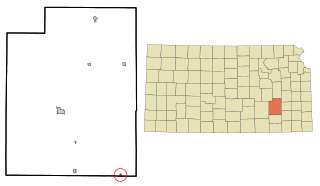
Fall River is a city in Greenwood County, Kansas, United States. As of the 2020 census, the population of the city was 131.
Clyde Township is a civil township of Allegan County in the U.S. state of Michigan. The population was 2,084 at the 2010 census.
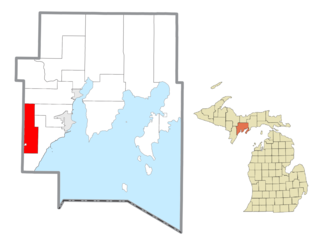
Bark River Township is a civil township of Delta County in the U.S. state of Michigan. As of the 2010 census, the township population was 1,578, down from 1,650 at the 2000 census. The township takes its name from the Bark River.
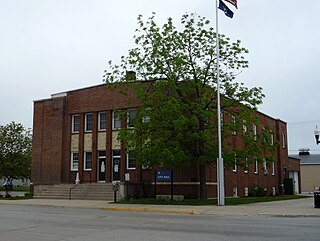
Gladstone is a city in Delta County in the Upper Peninsula of the U.S. state of Michigan. First settled in 1877, Gladstone's original name was Minnewasca. The population was 5,257 according to the 2020 census. U.S. Highways 2 and 41 run concurrently through the city, connecting it to various other communities in the Upper Peninsula. The city of Escanaba lies roughly 14km (9mi) to the south.

Norway is a city in Dickinson County in the U.S. state of Michigan. The population was 2,845 at the 2010 census. It is part of the Iron Mountain, MI–WI Micropolitan Statistical Area.

Bessemer is a city in the U.S. state of Michigan. As of the 2020 census, the city population was 1,805. It is the county seat of Gogebic County.

Erwin Township is a civil township of Gogebic County in the U.S. state of Michigan. The population was 326 at the 2010 census, down from 357 at the 2000 census.

Ironwood is a city in Gogebic County in the Upper Peninsula of the U.S. state of Michigan, about 18 miles (29 km) south of Lake Superior. The city is on US Highway 2 across the Montreal River from Hurley, Wisconsin. It is the westernmost city in Michigan, situated on the same line of longitude as Clinton, Iowa and St. Louis, Missouri. The population was 5,045 at the 2020 census, down from 5,387 at the 2010 census. The city is bordered by Ironwood Township to the north, but the two are administered automously.

Ironwood Charter Township is a charter township of Gogebic County in the U.S. state of Michigan. The population was 2,333 at the 2010 census. The city of Ironwood borders on the south, but the two are administered autonomously.
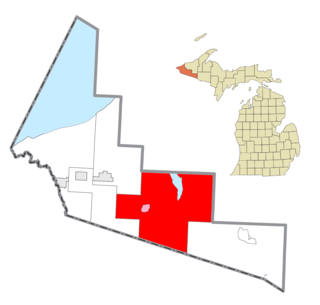
Marenisco Township is a civil township of Gogebic County in the U.S. state of Michigan. The population was 1,727 at the 2010 census, a significant increase from 1,051 at the 2000 census.

Watersmeet Township is a civil township of Gogebic County in the Upper Peninsula of the U.S. state of Michigan. The population was 1,417 at the 2010 census, slightly down from 1,472 at the 2000 census. Chippewa students made up half of the student body and winning high school basketball team in the early 2000s. It was featured in the 2007 documentary Nimrod Nation, shown on The Sundance Channel.

Crystal Falls is a city and the county seat of Iron County, Michigan. As of the 2020 census, the city population was 1,598. The city is located within Crystal Falls Township, but is a separate municipal entity. The area first developed as a major center for iron mining and the timber industry; it has become increasingly popular for tourism in recent years.

Montague is a city in Muskegon County in the U.S. state of Michigan. The population was 2,361 at the 2010 census. The city is located within Montague Township, but is politically independent.

Manistique is the only city and county seat of Schoolcraft County in the U.S. state of Michigan. As of the 2020 census, the city population was 2,828.
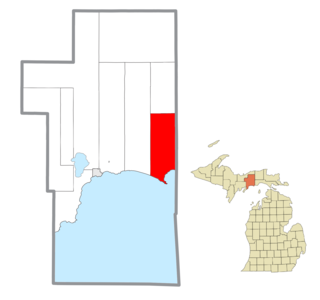
Mueller Township is a civil township of Schoolcraft County in the U.S. state of Michigan. The population was 260 in 2020.

Thompson Township is a civil township of Schoolcraft County in the U.S. state of Michigan. As of 2020, its population was 808.

Auburn is a borough in Schuylkill County, Pennsylvania, United States. The population was 663 at the 2020 census.

Sanborn is a town in Ashland County in the U.S. state of Wisconsin. The population was 1,331 at the 2010 census. The unincorporated communities of Bayfront, Birch, Birch Hill, Diaperville, Franks Field, New Odanah, Odanah, and Sedgwick are located in the town. Long Island, one of the Apostle Islands, is also a part of the town. The entire town is part of the Bad River Reservation of the Bad River Band of the Lake Superior Tribe of Chippewa Indians.

Hurley is a city in and the county seat of Iron County, Wisconsin, United States. The population was 1,547 at the 2010 census. It is located directly across the Montreal River from Ironwood, Michigan.





















